There’s a lot to cover on Wednesdays. We should know, as collectively, we read an insane amount of comics. Even with a large review staff, it’s hard to get to everything. With that in mind, we’re back with Wrapping Wednesday, where we look at some of the books we missed in what was another great week of comics.
Let’s get this party started.
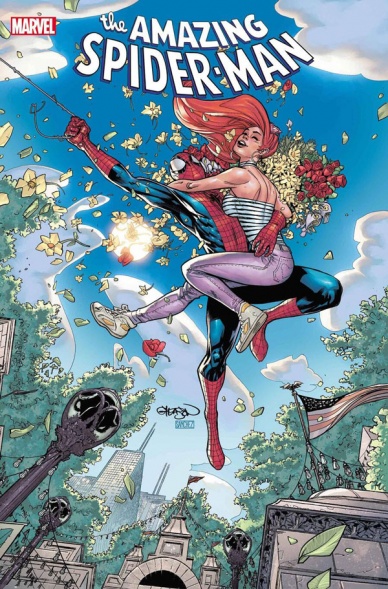
Amazing Spider-Man #74
Written by Nick Spencer, Christos Gage, Zeb Wells, and Sean Ryan
Penciled by Marcelo Ferreira, Mark Bagley, Zé Carlos, Dio Neves, Carlos Gómez, Ivan Fiorelli, Humberto Ramos, Todd Nauk, and Gustavo Quarte
Inked by Wayne Faucher, Marcelo Ferreira, Andrew Hennesy, Andy Owens, Zé Carlos, Carlos Gómez, Ivan Fiorelli, and Victor Olazaba
Colored by Andrew Crossley, Edgar Delgado, Alex Sinclair, Rachelle Rosenberg, and Dee Cunniffe
Lettered by Joe Caramagna
Reviewed by Quinn Tassin
Woof. I’ve never actually had that reaction to something but my god, “Amazing Spider-Man” #74 was bad. So bad, in fact, that it’s difficult to properly break down to review. There’s simultaneously a lot going on in this issue and absolutely nothing of any substance. See, the whole conclusion to Nick Spencer’s exhausting run on “Amazing Spider-Man,” which seemed to be on a mission to fix every problem that had ever come up in the preceding 874 issues of the series, rests on the idea that Mephisto is behind every bad Spider-Man story. It’s always a dangerous idea to retroactively make one villain the puppet master behind a number old stories (looking at you, Spectre) but that’s an especially stupid narrative move when you’re putting said villain behind the dumbest stories of the last couple of decades.
Spencer made an active decision to bring in elements of Sins Past and One More Day because he somehow believed he could pull off something with it. Of course he couldn’t though! Nobody can! That’s the whole thing with really bad, stupid stories from comics-past. You can ignore them and nobody will care. Instead, we get an issue that features Mephisto as the architect of many of Peter’s most personal woes, yet another death of Harry Osborn, Sarah and Gabriel Stacy as major villains. In the letter editor Nick Lowe features at the end of the story, he points out that this issue ends where the whole run began, with Peter and Mary Jane in love and supporting each other. While narrative bookends are very much my cup of tea, it’s hard to say that anything in the middle needed to happen or was even worth anything. And lord knows “Amazing Spider-Man” #74 is a sloppy, overstuffed issue without a single emotionally resonant beat.
As for the art, some of it is good sometimes but there are so many pencilers, inkers, and colorists (just look at those credits above!) that it’s impossible for any of them to leave a real mark. We don’t get any great moments penciled by Spider-icons like Humberto Ramos or Mark Bagley that play to their strengths. We get a handful of pages from them that feel rushed at best and then a whole slew of pages by artists that haven’t been relevant to this run or to Spider-Man as a character. There’s not one person who does standout work because it all feels so disjointed and handoffs between artists come at seemingly random moments. This format only serves to make the artists seem inconsequential and makes an already grossly disorganized comic feel even less readable.
There are two redeeming elements of “Amazing Spider-Man” #74. The first is that Nick Spencer’s run is over and he can’t hurt us anymore. I relish in this less than I’d like to because I actually had high hopes for Spencer but nevertheless, thank god. The other saving grace here is the stories in the back of the issue.
Writer Christos Gage and artist Todd Nauk get the most time here with a lovely tribute to dear old Uncle Ben. We see an old neighbor of the Parkers who Ben inspired to get back on the wagon with his dedication to the neighborhood and to this neighbor in particular. It’s not a groundbreaking story in the slightest- Ben being a good, inspiring dude is kinda the whole premise of this series. Still, though, a grounded story that reminds us of Peter’s roots is welcome.
Continued belowSean Ryan and Gustavo Quarte deliver a cute two-page spread of the Spider-Man attempting to recap his whole history which includes a fun “We Didn’t Start the Fire” moment. It’s a spread that you might forget after closing the issue but it’s still a fun read. The issue ends with a peek at the future with a story by Zeb Wells drawn by Ivan Fiorelli about Ben Reilly’s one true love, Janine, being released from Prison by the Beyond Corporation to keep Ben loyal to them. It’s an interesting short story that gets us excited for the new writing team’s debut next week(!!!) but it does rely on a certain familiarity with Ben Reilly’s past that the average reader might not have. We haven’t seen this character since 1996, after all. But, still, it’s easy enough to get the gist without knowing much and hit promises a better comic than the one we got today.
Final Verdict: 3.0- “The Amazing Spider-Man” #74 is a fittingly awful conclusion to a Spider-Man run that rarely understood what made the character so iconic.
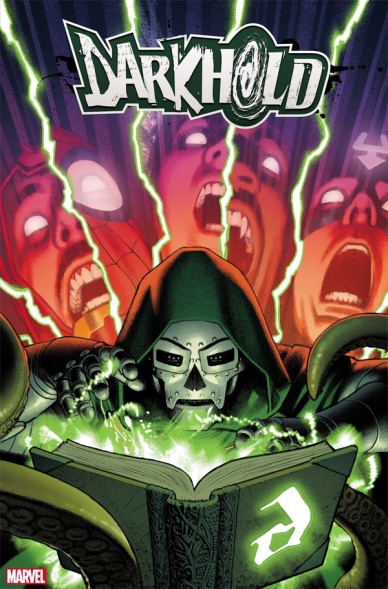
Darkhold Alpha #1
Written by Steve Orlando
Illustrated by Cian Tormey
Colored by Jesus Aburtov
Lettered by Clayton Cowles
Reviewed by Gregory Ellner
The apparent Marvel October event of 2021 is off to an interesting start with Steve Orlando’s “Darkhold Alpha” #1 one-shot. Orlando has experience in horror with the ‘Curse of the Man-Thing’ series of one-shots, not unlike the setup for this event, along with two of the ‘Extreme Carnage’ stories, and so he has shown himself capable of horror-based tales. Most of the characterization is entertaining enough for an introduction. However, there are elements that seem too simplified or unfocused. Doctor Doom appears far too confident in his own abilities (which considering this is Doctor Doom is really saying something), to the point of a lack of intellect. Similarly, all of the other characters just seem to… be together without much of a cut to explain exactly how they arrived where they are, entirely in order to set up the five coming one-shots under other writers. In effect, by focusing on setup for what is next, Orlando sacrificed anything to both make “Darkhold Alpha” #1 special on its own, and created unnecessary exaggerations of key characters.
In contrast against the problems with the script, Cian Tormey does a good job on the artwork of “Darkhold Alpha” #1. The composition of each panel helps to showcase each hero (and villain), especially in action. The darker forms of certain characters appear to be almost parodies of darker, edgier works, but given the context it functions perfectly. Certain key figures have very expressive faces, driving home the seriousness of the situation even if the script makes it a bit harder to take in. The relatively thick inking also helps to give even the more serious situations a slightly exaggerated, and thus less stressful, tone.
Jesus Aburtov’s colors, meshing dark shadows and bright lights, help put across the magical mishaps at work, especially when contrasting the darkness of the magic against the bright costumes or armors on display. The overall effect is one of relatively lighter heroes (for the most part) coming up against magical cosmic horror in a big way.
Final Verdict: 6.5– Although the artwork is good, as are the colors, the script of this debut is too focused on being an introduction and not enough on actually standing out in a way that is not out-of-character for participants who would attempt to do so.
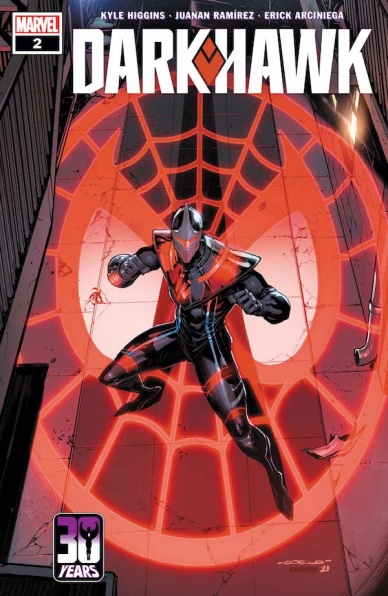
Darkhawk #2
Written by Kyle Higgins
Illustrated by Juanan Ramirez
Colored by Erick Arciniega
Lettered by VC’s Travis Lanham
Reviewed by Alexander Manzo
“Darkhawk” continues the story of a young protagonist, Connor, who stumbles into armor that helps him become a superhero in a time in his life when he feels like everything that he’s ever known is crashing down. The main character is struggling with his recent diagnosis of MS, which takes up the majority of the issue, that much like the main character, keeps the story very grounded. Kyle Higgins has a knack for creating characters in small parts that some might deem insignificant. Still, to the hero, it’s a small community of people that actually care about one another, and rather than get out, they’d instead protect what’s been created. Higgins also has established in two issues the bravery that it takes to jump into battle without hesitation and the willingness Connor has to go against his best friend to do the right thing.
Continued belowHiggins switches the narrative during the last page of the story by instead of continuing to have the hero go against his best friend, it could turn into a revenge story by the death of that same friend. This issue being part of a five-issue mini-series and already killing main characters shows that no one is really safe or protected.
The art by Juanan Ramirez helps bring this story to life with his ability to create an animated atmosphere during the fight scene with the group of thugs. Ramirez outlines Darkhawk’s movements and gives the reader the chance to see the speed and strength of the armor by moving from one thug to the next while simultaneously slicing the guns they’re using.
Action isn’t the only tool in Ramirez’s belt for creating a solid atmosphere. At the beginning of the issue, there’s a close-up of Connor preparing a needle for his first MS injection, and the reader can feel his hands shaking as he measures the correct amount. Erick Arciniega uses a lot of neutral greys throughout the city scenes that help establish a small inner-city vibe.
Final Verdict: 7.8 – Solid issue to check out in this mini-series, but the fight scene was relatively short to help it be established for a book of the week.
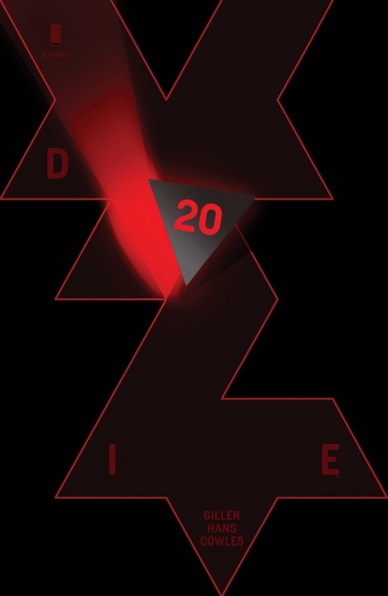
Die #20
Written by Kieron Gillen
Illustrated and Colored by Stephanie Hans
Lettered by Clayton Cowles
Reviewed by Elias Rosner
“Die” #20 is a strange, strange ending to a series all about plumbing the depths of our fascination with RPGs & their diced mechanics. It was about more than that, of course. It was about the freedoms and affordances a fantasy can embolden. It was about what it means to escape and where the value in escaping lies. It was about trauma and sacrifice and vampires and world building and rules and failure and even more than that.
However, issue #20 concerns itself mainly with asking a simple question: What Am I To You? So, it feels appropriate to read the issue through that question. “Die” #20 is, to me, the culmination of the final arc’s concern with the dungeon and its inward journey. It was about reflecting on the format & its mechanics and using its characters to highlight and illuminate it all. It’s “Die” at its most obtuse, at its least bombastic, and at its more heartfelt.
Stephanie Hans’ art is somber and dark throughout, showing us her strengths in the fantasy while unfortunately pointing out her weaknesses in the mundane, with painted shadows that sit too heavy on faces and obscure important defining characteristics in the same moment she perfectly captures the complicated mix of anger, worry, sadness and joy in the returned party’s faces. Cowles, as ever, doing gorgeous lettering work that effortlessly floats along the page, channeling the booming voice of Die, the commanding, terrifying Dictatorial commands, and the sans-serif, vulnerable talking of the cast.
I leave “Die” frustrated but fulfilled not because the story did not end – it did – nor because it was poorly told – it wasn’t – but because it was meant to leave me thinking and chewing on its ideas. What I wanted was not what I got but what I got was what was right. “Die” #20 is like the end of any good DnD campaign. The dungeon is conquered, the party facing the successes and consequences of their actions, and they split once more, going to lives we will never see unless we choose to imagine them again. The story of these six is over, even as for some, it begins anew but the ideas, the game goes on, ready to be iterated on and ready to shock, amaze and horrify all over again.
Games rarely go as you imagine, after all.
Final Verdict: 8.5 – An ending that will frustrate all in the same ways the series as a whole did but in that frustration, a story told all too perfectly.
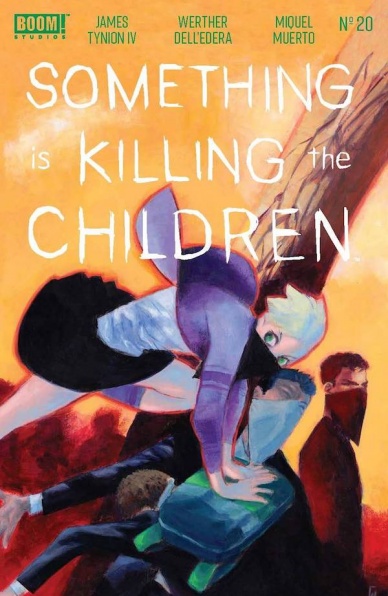
Something is Killing the Children #20
Written by James Tynion IV
Illustrated by Werther Dell’Edera
Colored by Miguel Muerta
Lettered by Andworld Design
Reviewed by Henry Finn
“Something is Killing the Children” #20 continues the origin story of Erica Slaughter and we are treated to a deeper look inside the mechanisms of the Order of St. George that the House of Slaughter is built on. Figures that started off as somewhat caricature-like in the beginning of the series are fleshed out into three-dimensional characters with this issue.
Writer James Tynion IV takes his time with this issue, unafraid to devote the entire book to character exposition and world-building. The legacy of Erica Slaughter is developed through the reactions of the supporting characters around her. Within this flashback we start with her two mentors Jessica and Gary Slaughter drowning their sorrows in alcohol; already sure that Erica is dead from facing the monster who killed her family in her trial of initiation. The fact everyone (except Aaron with his youthful optimism) are so sure she died makes the moment even more dramatic when she appears unharmed and ready for more. This juxtaposition of their expectation to find nothing but body parts instead of a fully intact little girl is a savvy way to build the size of her myth. She is not just another monster hunter, but a special one, an underdog that somehow manages to overachieve.
The beauty of revealing her backstory so late into the series is that in retrospect it makes you appreciate her current day accomplishments even more, and builds up the suspense of what made her leave the order. Tynion breezes through an explanation of the separate groups within the House of Slaughter and their job functions within a double-page spread that artist Werther Dell’Edera handles deftly as usual.
What Dell’Edera does so well is create a rhythm and timing within pages in ways that add to the character development. For instance in a pivotal scene that brings Erica to the grand Old Dragon for the first time, he switches from an average of 4-6 panels a page for the whole book to 8 panels a page during 2 double-page spreads. This gives us a faster pattern similar to the way a precious kid might get out a story. He also fills tight panels with moments of silence with an extreme closeup that says a thousand words which really heightens the emotional weight meaning of the dialogue.
Colorist Miguel Muerta creates a nostalgic look by washing most of the scenes in a golden orange hue, which serves to help plant the story in the past. He handles the scene with Erica and the Old Dragon with a soft touch, motivating each panel by fire light and not being afraid of deep shadows to create a moody contrast.
Final Verdict 7.9 – A solid building block to the story of Erica Slaughter that adds a weight to all of the story that preceded this arc.






